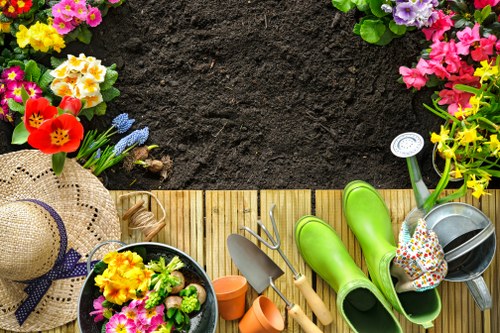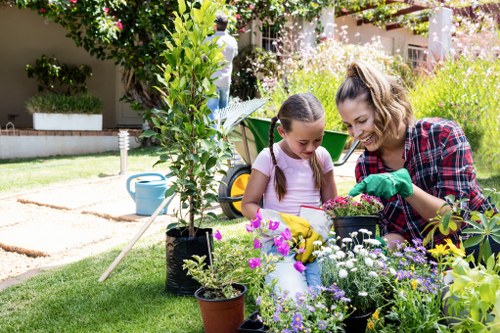Enhancing Your Lawn Care: The Role of Garden Fence Installation in Lawn Mowing
Introduction to Garden Fencing and Lawn Maintenance

Maintaining a pristine lawn requires more than just regular mowing. **_Garden fence installation_** plays a pivotal role in ensuring that your lawn remains healthy, well-defined, and protected. By integrating a sturdy fence into your landscape, you can enhance both the aesthetics and functionality of your outdoor space.
Fences act as barriers, keeping unwanted animals and pests at bay, which can otherwise damage your lawn. Moreover, they provide clear boundaries, making lawn mowing more efficient and less time-consuming. In this comprehensive guide, we'll delve into the various aspects of garden fence installation and its impact on lawn mowing.
Whether you're a seasoned gardener or a homeowner looking to improve your yard, understanding the synergy between fencing and lawn care can lead to a more beautiful and manageable outdoor environment.
Benefits of Installing a Garden Fence

Installing a garden fence offers numerous benefits that extend beyond mere enclosure. Here are some key advantages:
- Protection: Fences deter animals such as deer, rabbits, and rodents from entering your garden and damaging your plants.
- Boundary Definition: Clearly marks the edge of your property, which simplifies lawn mowing by providing clear lines to follow.
- Privacy: Creates a private outdoor space where you can relax without unwanted interruptions.
- Safety: Keeps children and pets within the designated area, ensuring their safety during outdoor activities.
- Aesthetic Appeal: Enhances the visual appeal of your garden, adding structure and complementing the overall landscape design.
By addressing both practical and aesthetic needs, a well-installed garden fence can significantly improve your lawn care routine and the overall look of your property.
Moreover, the right fencing material and design can withstand the elements, reducing maintenance efforts and costs over time.
Choosing the Right Fence for Your Lawn

Selecting the appropriate fence is crucial for maximizing the benefits it offers to your lawn mowing and overall garden maintenance. Consider the following factors when choosing a fence:
- Material: Common fencing materials include wood, vinyl, metal, and composite. Each has its own advantages in terms of durability, maintenance, and appearance.
- Height: The height of the fence should be sufficient to deter the specific types of animals you want to keep out. For example, deer-resistant fences typically need to be at least 8 feet tall.
- Style: The fence should complement the architectural style of your home and the landscape design of your garden. Options range from traditional picket fences to modern horizontal slats.
- Purpose: Determine if the primary function is security, privacy, or decoration, as this will influence the type of fence you choose.
- Budget: Consider the cost of materials and installation to ensure the fence fits within your financial plan.
By carefully evaluating these factors, you can select a fence that not only enhances the beauty of your lawn but also facilitates easier and more effective lawn mowing.
Additionally, think about future maintenance requirements to ensure your fence remains in good condition for years to come.
Planning Your Fence Installation

Proper planning is essential for a successful garden fence installation. Follow these steps to ensure a smooth process:
- Survey Your Property: Measure the area where the fence will be installed and note any slopes or obstacles that might affect placement.
- Check Local Regulations: Obtain necessary permits and adhere to zoning laws or HOA guidelines that may dictate fence height, style, and placement.
- Mark the Fence Line: Use stakes and string to outline where the fence will be placed, ensuring it aligns with property boundaries.
- Choose Gate Locations: Determine where you want to place gates for easy access to the garden and lawn.
- Prepare the Ground: Clear the area of debris and ensure the soil is suitable for fence posts, which may require digging post holes.
Effective planning minimizes unexpected challenges during installation and ensures that the fence serves its intended purpose seamlessly.
Additionally, considering the aesthetics and functionality during the planning phase can lead to a more harmonious integration of the fence into your garden.
Installation Process

Once planning is complete, the actual installation of the garden fence can begin. Here’s a step-by-step guide:
- Set the Fence Posts: Dig holes at regular intervals based on the fence design and insert the posts. Ensure they are level and secure using concrete if necessary.
- Attach the Fence Panels: Once the posts are in place, attach the fence panels or pickets according to the chosen style, ensuring even spacing and alignment.
- Install Gates: Secure gates to the designated posts, ensuring they open and close smoothly.
- Finishing Touches: Paint or stain the fence if needed, and add any decorative elements to enhance its appearance.
- Inspect the Fence: Check for any gaps or weaknesses and make necessary adjustments to ensure the fence is sturdy and functional.
Following these steps carefully will result in a well-installed fence that serves its purpose effectively, making lawn mowing safer and more efficient.
Remember to regularly inspect and maintain your fence to prolong its lifespan and maintain its appearance.
Maintaining Your Garden Fence
Proper maintenance of your garden fence is essential to ensure its longevity and effectiveness in lawn mowing. Here are some maintenance tips:
- Regular Inspections: Check for any signs of damage, such as broken panels or loose posts, and address them promptly.
- Cleaning: Remove dirt, debris, and any growths like moss or algae that can affect the fence’s appearance and integrity.
- Repairs: Fix any damage immediately to prevent further deterioration and maintain the fence’s functionality.
- Painting or Staining: Apply fresh paint or stain periodically to protect the fence from weather elements and enhance its look.
- Vegetation Control: Keep plants and grass trimmed around the fence to prevent overgrowth and ensure easy access during lawn mowing.
Consistent maintenance not only extends the life of your fence but also ensures that it continues to support your lawn care efforts effectively.
By investing time in upkeep, you can enjoy a beautiful and functional garden fence for many years.
Integrating Fence Design with Lawn Mowing Practices
Effective integration of your garden fence design with your lawn mowing practices can lead to a more efficient and aesthetically pleasing yard. Here’s how:
- Clear Boundaries: A well-defined fence provides clear lines for lawn mowing, reducing missed spots and ensuring an even cut.
- Access Points: Strategically placed gates allow easy access to different sections of the lawn, facilitating efficient mowing.
- Shade and Sun Management: Understanding how your fence affects sunlight exposure can help in planning mowing schedules and plant placements for optimal grass growth.
- Tools and Equipment Storage: Utilize fence space to install racks or hooks for storing lawn mowing equipment, keeping your tools organized and easily accessible.
- Aesthetic Continuity: Choose fence designs and colors that complement your lawn and garden, creating a cohesive and visually appealing outdoor space.
By thoughtfully integrating your fence design with your mowing practices, you can enhance both the functionality and beauty of your lawn.
This holistic approach ensures that your garden remains in top condition with minimal effort.
Choosing Professional Installation Services
While DIY fence installation is an option, hiring **professional services** can ensure a higher quality and durability. Here’s why you might consider professional installation:
- Expertise: Professionals have the knowledge and experience to handle various fencing materials and complex installation challenges.
- Efficiency: Skilled installers can complete the job faster and more accurately, saving you time and effort.
- Quality Assurance: Professional services typically offer guarantees, ensuring that your fence is built to last and meets your expectations.
- Permitting and Compliance: Professionals are familiar with local regulations and can handle the necessary permits, ensuring your fence complies with all laws.
- Cost-Effectiveness: While there is an upfront cost, professional installation can prevent expensive mistakes and reduce long-term maintenance costs.
Investing in professional fence installation can provide peace of mind and ensure that your garden fence effectively supports your lawn mowing and maintenance efforts.
Additionally, professionals can offer valuable advice on the best fencing options for your specific needs and landscape.
Cost Considerations
Understanding the costs involved in garden fence installation is crucial for budgeting and planning. Here are the main factors that influence the cost:
- Material: The choice of material significantly affects the overall cost. For example, wood is generally more affordable than metal or composite materials.
- Height and Length: Taller and longer fences require more materials and labor, increasing costs accordingly.
- Design Complexity: Intricate designs with decorative elements will cost more than simple, straightforward fences.
- Labor: Professional installation fees vary based on location, the complexity of the project, and the reputation of the service provider.
- Permits and Regulations: Costs associated with obtaining necessary permits and ensuring compliance with local laws should be factored in.
By understanding these factors, you can better estimate the budget required for your garden fence installation project.
It’s also advisable to obtain multiple quotes from reputable installers to ensure you receive competitive pricing and quality service.
Sustainability and Eco-Friendly Options
Eco-conscious homeowners often seek sustainable fencing options that minimize environmental impact. Consider the following eco-friendly materials and practices:
- Reclaimed Wood: Using reclaimed or recycled wood reduces the demand for new timber and promotes sustainable forestry practices.
- Metal Fencing: Metals like aluminum and steel are durable and recyclable, making them environmentally friendly choices.
- Composite Materials: Made from recycled plastics and wood fibers, composite fences offer durability with a lower environmental footprint.
- Natural Barriers: Incorporating living fences using hedges or bamboo can provide a natural and sustainable boundary.
- Low-VOC Finishes: Choose paints and stains with low volatile organic compounds to reduce harmful emissions.
Opting for sustainable fencing solutions not only benefits the environment but also contributes to the long-term health of your garden and lawn.
Furthermore, eco-friendly fences often require less maintenance and can enhance the natural beauty of your outdoor space.
DIY vs. Professional Installation: Making the Right Choice
Deciding between DIY fence installation and hiring professionals depends on various factors:
- Skill Level: If you have experience with construction and the necessary tools, a DIY approach might be feasible.
- Time Commitment: DIY projects can be time-consuming. Consider whether you have the time to dedicate to the installation process.
- Budget: While DIY can save on labor costs, potential mistakes might lead to higher expenses in the long run.
- Project Complexity: Complex designs or challenging terrains may be better handled by professionals to ensure quality and durability.
Weighing these factors will help you determine the best approach for your garden fence installation.
If you’re unsure, consulting with a professional can provide insights into the scope of the project and help you make an informed decision.
Enhancing Garden Aesthetics with Fencing
A well-chosen fence can significantly enhance the overall aesthetics of your garden. Here’s how to achieve a visually appealing outdoor space:
- Complementary Colors: Select fence colors that complement your house and garden plants, creating a harmonious look.
- Decorative Elements: Incorporate decorative posts, lattice work, or finials to add character and style to your fence.
- Integrated Lighting: Installing lighting along the fence can highlight its features and provide safety during evening hours.
- Vertical Gardens: Utilize the fence as a support for climbing plants or vertical gardens, adding greenery and life to your outdoor space.
- Consistent Design: Ensure that the fence design aligns with the architectural style of your home and other garden features.
By thoughtfully designing and selecting your garden fence, you can create a beautiful and cohesive landscape that complements your lawn and garden.
Aesthetically pleasing fences can also increase the curb appeal and value of your property.
Impact on Lawn Health and Maintenance
Garden fences not only affect the appearance of your lawn but also its health and maintenance routines:
- Wind Protection: A fence can act as a windbreak, reducing wind stress on grass and preventing soil erosion.
- Shade and Sun Control: Properly placed fences can manage the amount of sunlight your lawn receives, promoting healthy grass growth.
- Debris Reduction: Fences can limit the amount of leaves, branches, and other debris that accumulate on your lawn, making mowing easier.
- Soil Retention: Prevents the washing away of topsoil during heavy rains, maintaining the nutrient-rich layer vital for grass health.
- Pest Control: Keeps pests away from your lawn and garden, reducing the need for pesticides and promoting a natural ecosystem.
These factors contribute to a healthier lawn that requires less intensive maintenance, allowing you to enjoy a lush and vibrant outdoor space with minimal effort.
Additionally, a healthy lawn enhances the beauty of your garden, making your home more inviting and pleasant.
Innovative Fence Designs for Modern Gardens
Modern fencing offers innovative designs that blend functionality with contemporary aesthetics. Consider the following trends:
- Horizontal Slat Fences: Featuring sleek horizontal lines, these fences provide a modern look while maintaining privacy.
- Living Fences: Incorporating plants and greenery into fence designs for a natural and sustainable barrier.
- Mixed Materials: Combining different materials, such as wood and metal, to create unique and visually striking fences.
- Minimalist Designs: Simple, clean lines and understated styles that complement modern garden layouts.
- Smart Fencing: Integrating technology, such as automated gates and security systems, for enhanced functionality.
These innovative designs not only serve their practical purposes but also elevate the aesthetic appeal of your garden, creating a stylish and inviting outdoor space.
Adopting modern fence designs can set your garden apart, showcasing your personal style and attention to detail.
Environmental Considerations in Fence Installation
When installing a garden fence, it's important to consider environmental factors to minimize your ecological footprint:
- Sustainable Sourcing: Choose materials that are sustainably sourced, such as FSC-certified wood or recycled metals.
- Local Materials: Using locally sourced materials reduces transportation emissions and supports the local economy.
- Wildlife-Friendly Designs: Avoid designs that trap small animals or birds, ensuring your fence coexists harmoniously with local wildlife.
- Water Management: Ensure that your fence design does not impede natural water flow, preventing erosion and waterlogging.
- Energy Efficiency: Incorporate elements that enhance energy efficiency, such as shading to reduce heat absorption in your outdoor living areas.
By integrating these environmental considerations, your fence installation can contribute positively to the sustainability of your garden and the broader ecosystem.
Environmentally conscious fencing not only benefits the planet but also enhances the natural beauty and health of your lawn and garden.
Maximizing Space with Fencing in Small Gardens
In smaller gardens, space optimization is key. A well-planned fence can help maximize your outdoor area effectively:
- Vertical Fencing: Utilizing vertical space with tall fences or trellises can create an illusion of a larger area and allow for climbing plants.
- Multipurpose Designs: Incorporate features like built-in seating, planters, or storage into your fence design to make the most of limited space.
- Light Colors: Lighter-colored fences can make a small garden feel more open and airy.
- Mirrors and Reflective Surfaces: Adding reflective elements to your fence can create a sense of depth and expand the visual space.
- Partitioning: Use fencing to divide the garden into smaller sections, each serving a different purpose, such as a seating area, flower bed, or vegetable patch.
By strategically designing your fence, you can enhance the functionality and appearance of a small garden, making it appear more spacious and organized.
These creative solutions ensure that even limited outdoor spaces can be both beautiful and practical.
Enhancing Security with Garden Fences
Security is a significant consideration for many homeowners when installing a garden fence. Here’s how fences can enhance your property’s security:
- Deterrent to Intruders: A sturdy fence acts as a visible barrier, discouraging potential intruders from attempting to enter your property.
- Controlled Access: Fenced areas allow you to control who enters and exits, enhancing the safety of your home and garden.
- Surveillance Integration: Combining fences with security systems like cameras and motion sensors can provide comprehensive protection.
- Solid Construction: Materials like metal or reinforced wood can prevent climbing and provide a robust defense against break-ins.
- Private Perimeter: A high fence ensures that your outdoor activities, such as lawn mowing, are private and not easily observed by neighbors or passersby.
Implementing security-focused fencing not only protects your property but also provides peace of mind, allowing you to enjoy your garden and lawn without concerns about safety.
Additionally, enhanced security can increase the value of your property by making it more attractive to potential buyers.
Conclusion: The Synergy Between Fencing and Lawn Care
Incorporating a garden fence into your lawn care regimen offers a multitude of benefits, from enhancing aesthetic appeal to improving functionality and security. **_Garden fence installation_** is a strategic investment that can transform your outdoor space, making lawn mowing more manageable and your garden more beautiful and secure.
Whether you choose to install the fence yourself or hire professionals, careful planning and consideration of your specific needs will ensure that the fence serves its purpose effectively for years to come.
Embrace the synergy between fencing and lawn care to create a harmonious and well-maintained outdoor environment that you can enjoy with pride.
Book your fence installation service now to elevate your lawn care and garden aesthetics to the next level!